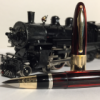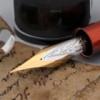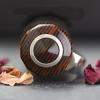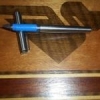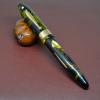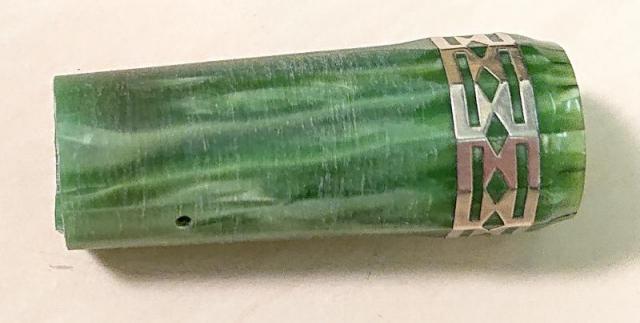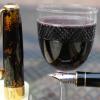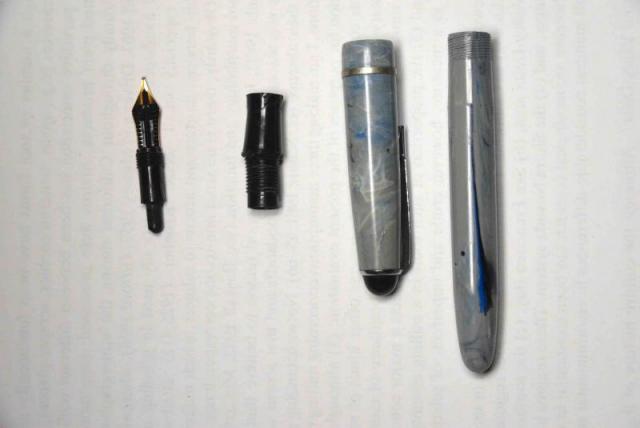Search the Community
Showing results for tags 'repair'.
-
I have a few Parker 51 pens that I've taken apart, cleaned out, and now it's time to replace their sacs, so I thoroughly removed any gunk and residue from the sac nipple, then shellac'd the new sac and left it to dry for a day or so. The result: after the shellac dries, it seems that it doesn't provide a good air seal. There seem to be "bubbles" under the sac between the "ridges" of the sac nipple, and as I apply some pressure on the sac, it starts to separate from the sac nipple very easily. For this reason, I'm too afraid to put this in a pen, because even though it sold of holds, I'm afraid it would come loose and start to leak soon. It also seems that the shellac is weak, if I apply very little force the sac comes off easily. I've now repeated the process 3 times, tried 2 different kinds of shellac, each time cleaning out the gunk and residue from the previous attempt carefully. But I always get the same result. What am I doing wrong? Is there a trick that I'm missing here? This feels very silly because I was able to do this successfully in the past but for some reason I can't get it right this time.
-
I have two Waterman E’Talon pens, which I have really enjoyed, plus an extra section and point. Problem is they all leak around the half ring clutch that secures the cap. I was able to dissemble one of the sections and believe the problem is the o-ring that fits above that ring (it’s red/orange). I’m thinking of using silicone to try to create a seal there. But that’s not the problem that is driving me crazy. I can’t dissemble either of the two other sections. I’ve tried hot water and physical pulling, but it won’t com apart. From the section I have apart, I know they do not screw, but push on. I am assuming there’s some kind of adhesive involved. To clarify, I can pull out the nib and feed, but the plastic piece that hold then won’t come out from the black plastic grip section. That, in turn, will not pull out of the metal piece that the barrel screws on to and that secures the offending clutch half ring. Any ideas about loosening things up?
-
I have a white Jinhao x450 that was all scratched up and looked like sh**t. So I decided to remove all of the white enamel and make it a brushed steel pen. I can screw off the cap phineal and clip no problem. However, I can't seem to get the end cap of the barrel to move at all. Is it also a screw on, or is it press fit or glued? The other option is to just try to tape the band off while grinding the paint off. JAB
-
Hi all, I took a punt on a vacuum fill Sheaffer Feather-Touch with a military clip cap (the type where the clip bends over the cap's top), and it's sold as unrestored. I'm in the UK, and wondered if anyone had a recommendation for a UK-based repair person?
-
While cleaning this pen I think I accidentally removed the nib-holder unit (marked in arrow) from the section. Although the nib holder unit has a screw, it was not screwed inside to the section. But, rather pasted to the inside of the section. When I try to insert the nib holder unit, it remains loose. What can I do in this situation? Is this damage irreversible? https://www.fountainpennetwork.com/forum/uploads/imgs/fpn_1597461428__j886_1.jpeg https://www.fountainpennetwork.com/forum/uploads/imgs/fpn_1597461497__j886_2.jpeg
- 3 replies
-
- jinhao
- jinhao-886
-
(and 2 more)
Tagged with:
-
Hi all ! I have an M800 that I recently dropped on the floor, while the cap was screwed. I was surprised to see ink all over the floor, and when I picked it up, the cap and the screwed nib and piston were separated from the section where the ink is stored. The section seems to have "popped out" from a collar. Has anyone experienced this? Since the nib is still screwed on the cap, it is hard to see exactly what happened. Any suggestions? Thanks !!
-
About a month ago, I friend of mine sent his Duofold ballpoint for service to Parker. The pen didn't work for some reason and was just a few months out of warranty, so he decided to sent it directly to Parker in France in order to have it serviced. The pen returned just this week and much to his surprise, it was returned stating that Parker NO LONGER repairs pens or pencils. If under warranty, they might replace the product with a similar one; out of warranty they are offering a 50% discount on any other Parker, Waterman or Rotring product of his choice! Can you believe this?
-
Greetings. I recently picked up a 333 1/2 for less than usual, knowing there would be issues. The body, section, and cap all look fantastic. The nib will need a little attention, but is salvageable and incredibly flexible. But the feed is clearly not original and undersized. I have the equipment and ebonite rod stock to create a new one, but I don't have any idea what the upper part (underside of the nib) looks like. All I can find is images of the underside of the feed. If anyone has any pix of one 't would be deeply appreciated. Dimensions would be even more appreciated. Best, Nick
-
I recently acquired a nice, unrestored Waterman 3 from the early to mid 1930s, in great condition save for a broken feed. Upon removing the remaining length of the feed from the section to commence with the pen's restoration, I noticed that the feed has 2 parts- the feed and an outer sleeve. I have never seen a 2-piece sleeved feed on a Waterman, although I have only restored a few other Watermans (a Purple 5, a 52, and a Dauntless). All things considered, this is the only US-made vintage pen I have found to have a 2-piece sleeved feed (in my limited experience, of course). I've been trying to locate information on this 2-part feed design, and I've come up with nothing. I'm planning to replace it with a spare Waterman #2 sized feed to match the nib and section so I have a usable pen. I feel like I may have stumbled upon an experimental/short-lived design, although it's worthless to collectors (and to me) since it's broken. However, I was wondering if there are any Waterman fans or collectors out there with more experience that might know more about my mystery 2-piece feed?
- 1 reply
-
- watermanfeed
- repair
-
(and 1 more)
Tagged with:
-
I would like to help a friend repair her Montblanc 221, black. It has a hairline crack on the plastic nib holder of the hooded nib. I dont have photo yet but the problem described to me seems a common problem of this model. My question is: must I use MEK, or is Loctite 480 sufficient? I havent been able to buy MEK where I am, but I found Loctite 480 online in Switzerland. I plan to leave the pen for 2 weeks after the glue gets into the crack. Not too optimistic about repairing cracks, but I must try at least. Otherwise her pen is a leaky unusable pen. The leak might not just come from the crack, but that would be the first suspicion. I much appreciate any suggestions.
-
I have a decent collection of the striped WEAREVER PACEMAKER pens, pictured below. I have 10 of the FPs and one mechanical pencil (2nd from left). I've collected this pen so far in four different colors. PenHero has covered Wearever pens quite extensively in other topics in the Other North American pens section, and has provided us with wonderful, professionally made photos, so I won't go over well-covered territory here. I've just provided various photos of my collection for what they are worth to you. My ultimate purpose here is to discuss a common repair issue with these pens -- the cracking of the section -- and to solicit recommendations about repair. These pens otherwise are relatively easy to fix when, for example, the button filler stops working. One can carefully remove the section, easily replace the rubber sac (if needed; so far not needed), reposition the lever and button mechanism, and get everything to work well. Because I'm a bit obsessive about cleaning my fountain pens, I also will remove the nib and feed (friction fit) to clean them, and then will reinsert them back into the section. If the section doesn't already have a crack, the reinsertion of the nib-feed has a tendency either to reveal a crack that already was there or to create a crack. That result may be contributed to by shrinkage of the section plastic over time. Although each section has a seam, the cracks I have seen or created thus far have not been in the seam. I now regret removing the nib-feed unnecessarily, as I perhaps could have avoided cracking the section of at least some of the cracked samples. The next-to-last photo, with better lighting, would better show the crack in one of the pens. You may be able to see slightly the reflection of the section crack on the bottom of the nib where it meets the section, but it's subtle in that photo. About half of these pens in my collection have a similar crack. What I have done with some success is to use a Q-Tip with super-glue to apply, in layers, the glue to the inside and outside of the section, and let it dry with each layer. As that very slightly reduces the space inside the section for the nib-feed, reinsertion of the nib-feed may stress the crack and require another layer or two of super-glue on the exterior of the section to hold in the ink. One may see a little bit of ink underneath the glue, which otherwise holds in the leakage to spare one's fingers an ink stain. When not leaking through a section crack, these Wearever Pacemakers are good writers for the price. The 14K medium nib is on the thinner side, but it writes smoothly with a bit of give to it, and the overall writing experience is nice for such a relatively inexpensive (then as new and now as vintage) fountain pen -- at least for my tastes. Any recommendations as how better to repair the section crack, assuming I've learned my lesson and will not remove the nib and feed just to clean them better? The photo just below may allow you to see the slight crack in the section; the crack is reflected onto the bottom of the nib very near the middle.
-
Anyone know if an Edson clip can be removed? I see a screw inside the cap, so I'm hopeful. I've also heaed the cap liner is glued in, so I don't want to mess with it unknowingly if I can help it...
-
I came across this pen that probably belonged to my grandfather. First of all I haven't been able to identify the pen or its age. It has a vacumatic fill and an ebonite feed. The ribbed section also seems to be made of ebonite and has some signs of whitening. The biggest problem with this pen is that the barrel has been sloppily glued to the section by some sort of adhesive, most probably many years after the pen was manufactured. The adhesive was quite brittle so I managed to carefully peel it off. What remains behind looks like damage to the barrel itself. The adhesive has dug small pits in the barrel material (maybe celluloid? Bakelite? I'd love to hear your thoughts). Even after the removal of the glue, I can't unscrew the barrel from the section and I'm too scared to force it. I'd really like to know what the pen is made of, how to restore whitening on hard rubber, what parts is the pen made of (threadded, glued) and how one would go about restoring it. I'd really appreciate your input on this pen as I'd be quite interested of restoring it myself.
- 5 replies
-
- sheaffer
- restoration
-
(and 1 more)
Tagged with:
-
Vintage celluloid usually shows some shrinking to various degrees. Depending on the kind of celluloid and brand, the shrinking can be enough for the cap bands to loosen. Sometimes you see such pens which even lost cap bands due to this problem. Is there any good way to fix this issue? Can you tighten the cap bands somehow?
-
I have Wing Sung 590 and I accidentally broken the feed. I glued it and it looked ok, then I filled my pen but get a lot of skipping. So I thought that I blocked channels with glue and I deepen the channel with scalpel, then tried to write. The result was even worse. Then I thought that may be I made a channel too deep so I placed a piece of thread at the end of the feed. And it worked! Now the question is: how to reduce depth of the feed? Thanks for any suggestions. P.S. Sorry for bad English.
-
It is an unfortunate reality that plastics deteriorate over time. With modern fountain pen feeds typically made of plastic, my beloved collection of 1970s student fountain pens is becoming susceptible to breakage. This holds true for my Montblanc Carrera pens, where the feed post (the bit that protrudes into the cartridge) is prone to breaking off. I would recommend against pressing a new cartridge into old pens with this feed type (not being a fan of using converters, I refill my old cartridges with a syringe). I have found many useful repair tips in this forum and it’s only fair that I share solutions that I have developed. In this article, I will explain a simple feed repair, should you suffer the breakage of the post from the feed. All you need is a drill with small bit, an ear bud and a very small pair of scissors (or a sharp knife). The initial steps are: Drill a small (say 1mm) hole into the centre of the broken feed;Cut a suitable length of plastic from the ear bud;Cut that section of plastic lengthways twice so that about a quarter of the circumference is removed.This is illustrated in the first photo below. On the left you see the small scissors that I used from a small key-chain multi-tool. For an easy comparison, in the photo below, I have placed the broken feed (with hole already drilled into the centre) on the right of an intact feed from another pen. All that is left to do now is to reassemble the pen. The first step is to roll the length of plastic from the ear bud in your fingers, until it has a circular cross section (albeit with a smaller diameter than the original length of ear bud). During assembly, I found it easier to place the new feed post (no glue needed) into the clear section (rather than into the feed itself). This is shown in the picture below. The final picture shows the reassembled pen. The ink flow after the repair is the same as what one would expect from a pen with an intact feed.
-
I currently have an old celluloid CS 479 from the early 1930s on my bench that, not surprisingly, needs a new sac. It's in very good condition otherwise. Since I have not that much experience with CS pens, I wonder if anyone here can tell me whether the section is friction fit or screw in? Thanks a lot in advance. P.s.: Sorry, my previous post had a typo in the title, which unfortunately I cannot edit. Maybe a moderator can remove the earlier post.
-
Pilot Murex - I had done some minor repair on this pen for the original owner but have since then acquired it for my own collection. For the repair I did , a full disassembly was not necessary. I pulled the cap off yesterday and the section came loose with it. This is what I saw. Is this normally adhered to the inside of the section like an inner cap in a pen cap? I don't seem to be finding pictures of such a part over the feed as of yet. I also need to disassemble the feed and section which I assume will take heat. The notches on the black section piece and the notches(tabs?) on the metal aren't matching. I am thinking perhaps the section was torqued at some point in the past. EDIT - After using some common sense I have the feed and all separated. I'll get the sleeve back into the section and go from there. BUT, what is the partial ring piece technically called? It was on the feed end of the threaded "coupler" the feed was screwed onto. It doesn't seem like part of the ring is missing so I am guessing this is the full piece. I am amazed it didn't come off and disappear into the pen part triangle. The Saint of tiny pen parts must be on my side today.
-
Does anyone know who the distributor is for Platinum in Italy, or where I could find a replacement cap otherwise for my 3776?
- 1 reply
-
- platinum
- distributor
-
(and 1 more)
Tagged with:
-
Dear fellow FPNers My beloved Parker Duofold International has begun developing issues lately, after years of being the most reliable pen I have ever known. I am not as well versed in fountain pen mechanics as I would wish, and maybe I have done something that hurt it, and I just don't know. I was hoping that someone here with a lot more knowledge than me could help me out? I read a bit in the forums and thought it might be a feed issue, but I wanted to ask again to make sure I'm not jumping to conclusions. The issues are: - I first began noticing that ink would dry in if I didn't write with it for 2 days, fair enough, that's normal for a fountain pen. I added water to it a few times and it worked again. - After doing this 2 times, I decided to give it a thorough clean to make sure no particles of ink or anything are stuck. I cleaned it with a bulb syringe until water ran clear and let it dry. I also unscrewed the metal part behind the feed and screwed it back on. Its been loose for a while. - When I filled it with ink today, and after I waited for a few hours to let the feed saturate, it started skipping after a few lines. It would only stop skipping if I really pushed the cartridge again (I only use Quink cartridges), until I guess the feed ran out of ink. I also noticed that the metal part under the feed was loose again, and tightening it helped as well. At times though, it would skip after I tightened it, still. I cleaned it out again, and am now waiting. Does anyone know what might be wrong? Any help would be super appreciated
- 17 replies
-
- parker duofold
- repair
-
(and 1 more)
Tagged with:
-
I have had this ASC Bologna Extra for about a year, and was always curious about how to disassemble it because one day I will have to re-sac it. Today, with a thought derived from another thread on FPN, I was feeling brave and did it. First of all, I would like to thank FPN member sannidh and Youtuber sbrebrown for their answer and video to help me with this disassembly. sannidh's original post is here (a different topic but indirectly related to this because of the same filling mechanism): https://www.fountainpennetwork.com/forum/topic/351582-a-review-of-the-wahl-eversharp-decoband-in-rosewood/page-1 sbrebrown's video relevant to disassembly of this model is: Please see minute 4:44. Please see below photos: You can unscrew the nib/feed unit out of the section. You can unscrew the section out of the barrel. Observations: 1. There was no shellac or other heat sensitive adhesive on plastic nib collar threads so unscrewing was rather easy, both the nib unit and the section. 2. The nipple size seems to be for size 22 sac (or one size bigger or smaller), but the sac seems thinner in diameter. I could be wrong but it looks at least in my case, the sac size might be chosen to accommodate the narrow diameter of the brass casing. Otherwise the pen had to be made even girthier, which may not be possible depending on the diameter of their celluloid rods available. Or it's just fitted off centre in this case that it appears to be a smaller sac for the nipple. But my guess is the former. I didn't re-sac the pen, as it's still relatively new. When I do, I will first have to see if the sac with the right nipple size fits the brass casing. If not, a smaller size sac will have to do, even though it might be a tighter than ideal fit on the nipple. 3. The section is rather thin (partially inner-lined with brass). Be careful not to over-turn the nib unit when you screw it back on, to avoid any chance of cracking the section. Hope this satisfies your curiosity as it did for mine, and might be helpful to you one day. Regards, como
- 19 replies
-
- asc
- armando simoni club
-
(and 3 more)
Tagged with:
-
I wanted to share with you the repair of a a crumbled barrel end of a gorgeous oversize Wahl Eversharp Doric in cathay color. A soon as I get this pen (50$) I had the bad idea to push a little on the crumbled crown from the barrel end and boom, it broke up in pieces... Here is the initial state... I cleaned the end barrel removing all the crumbled celluloid. I decided to rebuild the Barrel end crown using another broken doric cap in cathay color (junior size) (also crumbled at the end): here is this cap (yellow arrow shows instable cracks, I got it on ebay for 30$): I first removed all the "unhealthy celluloid" (broken or crumbled parts) from the broken doric cap. I then used sand paper to remove the discolored superficial layer of the cap. Here is what remained of the cap: Then the barrel was split in half using a fine jeweler's saw and sawn the splited barrel in "tiles" of the width of the barrel end: here are the tiles: Then the tiles were flattened and glued together using acetone welding. You must immerge a short time each tiles in acetone to allow them to soften. The tiles are then ready to be assembled two by two by pressing them against each other. On the left of the picture you can see tiles already assembled and on the right a fresh one ready to be soaked in acetone and welded to the other ones. You then get a kind of celluloid dice formed by successive acetone welded layers: And now the hardest part!: you have to wait for 3 months to allow the dice to dry (to shrink). It's now time to acetone weld the dice onto the end barrel: Then the crown is sculpted, sanded it down to the 12 lateral facets of the doric barrel with rough sand paper. To guide you and to avoid damaging the lateral facets of the barrel you have to protect each facet with a piece of metal taped with double sided scotch tape onto the barrel facet: Here is the rough result on the left (without fine sanding) and with fine sanding on the right (up to 5000 grit sandpaper): When you have finished with sculpting the 12 lateral facets it's time to sculpt the crown (end side). You have to sand it using a metallic guide taped with regular tape on the lateral facets: After finishing and sanding using Micromesh (grit 8000/12000) here is the result: The pen after a year of use didn't show any signs of crumbling, there was no celluloid shrinkage either:
-
So that kind of sucked: sent a pen I inherited off to Montblanc because it wont pump ink. Figured old piston gaskets had crumbled or something, which I thought would be a simple matter for them. Not so. They returned it unfixed with a charming letter saying they were out of spare parts and unable to repair it to a state of perfection. I would have thought in this day and age with CNC routers, lathes and 3D printers... I would honestly have settled for a state of working. Anyhow, does anyone know anyone who might give it a try? Kind regards, ius
-
I bought a Conklin Mark Twain Crescent Filler a while back and inked it up and noticed ink was seeping into the section. I contacted Yafa and they are repairing or if they cant repair they will allow me to select any pen of equal value. I've been told that repair is more likely. It's been a few weeks and it is still being repaired. I asked for an ETA and the answer I was given was more or less when the tech is finished. I know each pen repair is different, but I'm sure many of you have experience in this area; how long typically do pen repairs take? I know an exact time frame is unreasonable to expect but I would welcome a ballpark.
-
At an antiques fair I was recently GIVEN a fountain pen by a stall holder who just wanted rid of it. Couldn't say no, could I? And of course Ive got to get it back into working order... It is an Osmiroid, a brand I remember from school, long ago. Research shows it is an Osmiroid 65. It is not a lever filler. I've ordered a converter from ebay. The nib says OSMIROID ROLATIP MEDIUM SOFT ENGLAND, and looks to be in perfect order. The problem is the section. When unscrewed it is badly bent - see photo. All in all the pen has had a lot of abuse. There are tooth marks on the section, as if someone has tried to open it with their teeth. Also the bottom of the barrel is irregular, looks like a knife has been inserted in an attempt to open the pen. Can anyone tell me how to separate the nib from the feed? And, more importantly, where can I get a replacement section? There don't appear to be any on ebay. NB this is the normal section, not the long cradle-shaped thing for holding a calligraphic nib. I gather Osmiroid nibs fit Esterbrook sections. Does this mean that an Esterbrook section would take the Osmiroid nib and fit the Osmiroid barrel? All suggestions gratefully received. Peter







